Text & Photos by Jeff W. Zimba
With traditional bullet weights ranging from 55 to 62 grains, the AR-15/M16 weapon system is an impressive workhorse with a long history of service. Even though it has been the primary United States infantry weapon for over 40 years, the small 5.56x45mm round has been the subject of controversy for decades, sworn at by some and sworn by, by others. Regardless of your personal opinion of the Black rifle in the past, when you chamber this popular system with a 250-grain bullet with a muzzle velocity of 2,200 feet per second, you may have an entirely new outlook on it.
Introduced late in 2007, the .450 Bushmaster is the brainchild of Bushmaster Firearms and enjoys a cooperative effort with Hornady Ammunition. This new round is adapted from a 6.5mm (.284) case necked off to accept a Hornady (.452-inch diameter) 250-grain SST bullet. Manufactured to the same length as a standard .223 round, it is fed with a very similar box magazine fitted with a new single-stack follower. (The new follower is necessary because of the increased diameter of the case). As a tribute to a vision of Col. Jeff Cooper who often referred to a large diameter, fast moving round, the .450 Bushmaster has been nicknamed the “Thumper.” With an impressive 2,800 foot-pounds of energy at the muzzle, it certainly seems fitting.
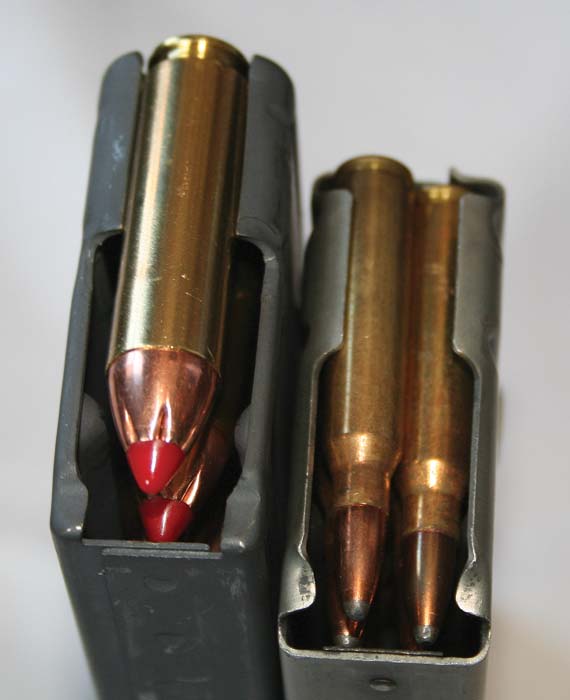
SAR received 2 variations to test for this article. The .450 Rifle has a 20-inch barrel and the .450 Carbine has a 16-inch barrel. Both barrels are ChroMoly Steel with Chrome lined chambers and bores and both utilize a right-hand twist with 1 turn in 24 inches to stabilize the heavy projectile. Both rifles are standard with an A3 Flat-Top upper receiver and free-floating aluminum handguard.
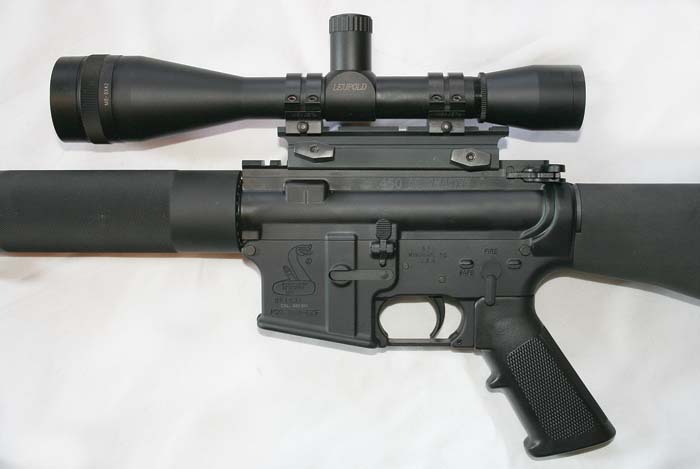
For the accuracy portion of our testing, the test rifle was topped with a BW Optic Y-TAC Scope and the carbine was fitted with a Leupold M8 Tactical scope.
Range Time
Tested on a sunny winter day, the mercury topped off around 45 degrees above zero. Targets were set at 100 yards and after a brief sighting-in period, the muzzle velocity of each variant was measured. According to the loading data on the Hornady box, the massive 250-grain projectile is supposed to be traveling 2,200 feet per second (fps) from a 20-inch barrel. We can confirm that Hornady did their homework as we recorded an average muzzle velocity of 2,203 fps. As expected, the carbine, with the 16-inch barrel, came in a little lower with an average of 1,705 fps. According to the manufacturers data the muzzle energy from the 20-inch barrel is an impressive 2,700 foot-pounds.
The muzzle velocity testing was almost an expected result based on our previous outings with Hornady ammo. They are often extremely accurate in their performance data, and proved once again to be on target.
The rifle and ammo accuracy was something we were quite anxious to test. After all, you can push a big bullet fast, but if you can’t stabilize it and place it where you intend to, it doesn’t provide a very useful tool. With the test rifles sighted in with their perspective glass, it was time to check the performance of the overall system. The first gun tested was the 20-inch rifle with the BW Optic Y-TAC scope. 5 rounds were fired within a 2-minute period, taking plenty of time to examine the previous hit and readjust cheek weld. (The beauty of making such big holes is they are extremely visible at 100 yards with nominal scope power). This first group fired barely reached 1.5 inches at its maximum spread. This type of accuracy was consistent throughout the entire shooting session.
The second test was with the 16-inch barreled carbine combined with the Leupold M8 Tactical Scope. 5 rounds were fired in the same manner as with the rifle version with even better results. This first group with the carbine barely broke the 1.25-inch mark at maximum spread. Once again, continued shooting remained consistent and just as tight through the remainder of the afternoon.
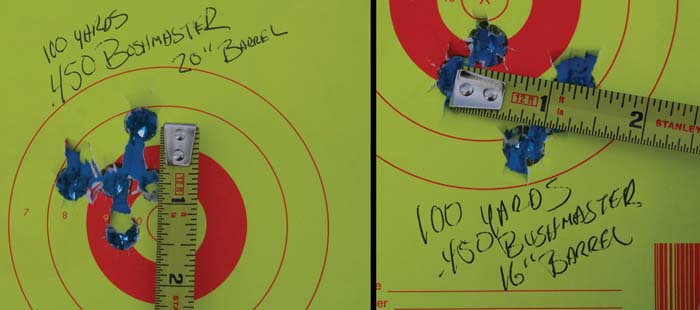
Thump!
The Bushmaster .450 is nicknamed “Thumper” for all the reasons pointed out above with the addition of one more. This rifle has a type of recoil that can only be described as a “thump.” The first time the rifle was placed on the bench and the trigger slowly squeezed during the sighting in process, the author was reminded it was not a .223 rifle. As the scope gently kissed the top of the shooting glasses, a quick smile and a tighter hold followed through the remainder of the accuracy testing. No more lax, light holds on this rifle. At least not until it was time to shoot off-hand through the screens for some muzzle velocity testing. The first off-hand shot had exactly the same effect as the first bench shot and from this point on it wasn’t repeated again.
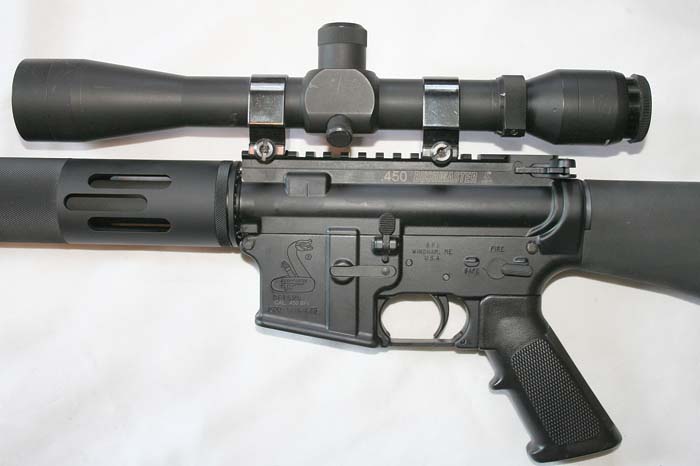
Before you get too concerned about excessive recoil, it is really not severe at all. It just isn’t a light .223. Neither gentle “tap” on the author’s glasses had any adverse effect nor left any mark. Even though it is a big, heavy round traveling very fast, the traditional direct gas impingement system combined with an effective buffer keep the recoil manageable. It is not a severe “snap” or “crack”, but more of a “push” like you would get from a medium gauge shotgun.
Conclusion
Given the number of people who typically believe “bigger is better” when it comes to stopping power, it would be hard to dislike this rifle system. Bushmaster and Hornady have made terrific partners in this joint effort as evidenced by the accuracy and consistency of this system. The load data was spot-on with our test data, and that indicates a serious amount of R&D on the part of all parties. The cost of ammo is not “crazy money” at a suggested retail (Hornady MSRP) of $37 per 20-round box either. It is not exactly surplus priced but it is not the kind of gun most would be firing a thousand rounds over a weekend. The recoil, while greater than the little .223 is very manageable and light enough for the author to comfortably fire several boxes of ammo in one setting.
Most parts of the .450 Bushmaster are “off the shelf” parts making the system a little more attractive to the tinkerers in our community. The trigger mechanism is standard as is the buffer system and spring. Most rail systems should work as long as the clearance issue is taken into consideration. The carbine used a standard front sight/gas block combination so anything is a go there. The rifle uses a low profile gas block and that is where the additional clearance will be a factor. The bolt carrier is the same as the others. While it was considered to swap it out for a full auto carrier and dropping in a registered lower, the 5-round magazine capacity was the main reason for forgoing this test. Keep an eye out for future magazine projects in the future but, for now, they are all only 5 rounds.
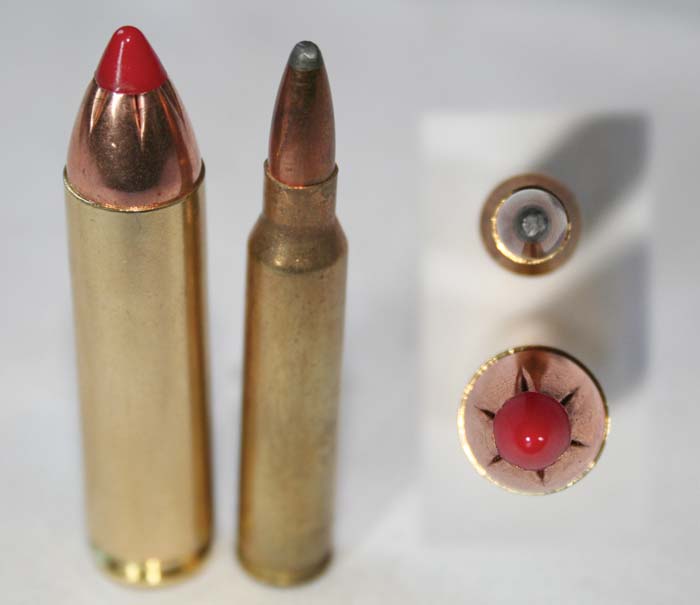
Both rifles were inspected and fired as they were shipped with no additional care or lube. Neither firearm malfunctioned in any way. After spending several hours with this combination it has already become apparent that the author will continue testing, right through the next season on Whitetail deer. If you are a fan of the Black Rifle and want to expand into a heavier caliber with high- grade performance, the .450 Bushmaster will not disappoint. It is quite impressive.
Sources
Bushmaster Firearms, Inc. Dept. SAR
999 Roosevelt Trail
Windham, ME 04062
(800) 998-7928
www.bushmaster.com
Hornady Mfg. Co.
Dept. SAR
Box 1848
Grand Island, NE 68802
(800) 338-3220
www.hornady.com
| This article first appeared in Small Arms Review V11N9 (June 2008) |











